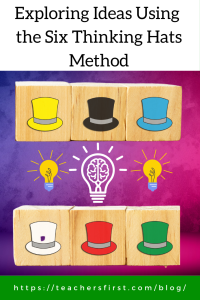Great ideas need landing gear as well as wings.
C. D. Jackson
Every March, International Ideas Month takes place. This observation recognizes the potential of ideas, even those that seem simple or unattainable. As educators, we both teach students about famous people who have formulated great ideas and inspire them to explore their own.
Coming up with an idea might be easy, but developing and turning ideas into reality takes more time. One way to help students think outside the box and analyze their ideas is to provide them with strategies for looking at their ideas through different lenses.
One technique to consider is the Six Hats Thinking Method, which is helpful for many deliberative processes, including decision-making and problem-solving. In this method, students explore ideas and information by putting on six different colored hats, each connected to a different perspective.
Let’s use the example of a student’s idea of eliminating homework to explore how to use the Six Hats Method. Although there isn’t a set order for using the hats in the thinking process, the white hat is a helpful starting point in this scenario.
- White Hat – Develop facts and information. The student starts gathering data related to their idea using a form or polling tool, then shares the results. This data collection includes simple questions, such as whether the respondent agrees that homework should be eliminated.
- Information-gathering tools: Microsoft Forms (reviewed here), Google Forms (reviewed here), or Poll Maker (reviewed here)
- Red Hat – Evaluate feelings and instincts. The student looks at their gut feelings and observes reactions from other students, teachers, parents, and administrators. The student gathers information to learn how strongly others feel about this issue and use it as a guide to understanding viewpoints other than their own.
- Tools to gather feelings: Classroom Screen (reviewed here) allows you to launch a quick poll where participants use emojis to record how they feel about eliminating homework. Flip (reviewed here) allows students to create and share a topic where interested parties can share their feelings about eliminating homework.
- Yellow Hat – What are the positives of this idea? The students brainstorm why this is a good idea and what positive effects it will have on the class.
- Tools for displaying positives: Canva for Education (reviewed here) has several ready-to-use pro/con templates like this one to help students share their ideas on eliminating homework. Use Google Slides (reviewed here) or Powerpoint (reviewed here) to create a slide for positive effects and another for the negatives.
- Black Hat – What are the negatives of this idea? The student gathers and displays perspectives on why eliminating homework is bad using the same tools discussed above with the yellow hat technique.
- Green Hat – Creativity and brainstorming. After considering all of the different perspectives, the student provides suggestions for implementing their vision and gathers input from others.
- Tools for brainstorming and creativity: TeachersFirst Edge: Concept Maps/Mind Maps has many free resources for creating and sharing ideas. Mindmaps (reviewed here) is an easy-to-use option that allows you to add ideas and edit colors to help visualize suggestions. For example, use one color for student-generated ideas, another for parent suggestions, and another for faculty ideas. Other concept map generators include options for collaboration, adding images and links, and more.
- Blue Hat – Reaching and sharing conclusions. After considering the many different viewpoints and coming to a decision, the blue hat helps students embrace rationality and provide conclusions. This is where your student shares the process they followed to reach a conclusion about the value of eliminating homework.
- Tools for presenting: Genially (reviewed here) offers several templates for creating interactive images and presentations. Create an interactive image that links to information gathered through the Six Thinking Hats Method.
Managing all of the different perspectives and viewpoints is crucial to successfully considering ideas. IdeaBoardz (reviewed here) has a ready-to-use whiteboard template students can use to organize and share all of the information gathered. Click Create to start a board, then select Six Thinking Hats as the format, then click + to add information to the six areas labeled for each hat. Students can share their board’s URL to collaborate with others or include it in their finished projects, or save it as a PDF or Excel file.
In addition to the exploration of student’s ideas, the Six Thinking Hats model is excellent for many other classroom uses and doesn’t always require the use of all six colors as part of the discussion:
- Assign a different colored hat to each group of students to use when comparing and contrasting characters’ actions in stories.
- Discuss events leading up to the American Civil War or the World Wars.
- Discuss the influence of social media on students.
- Use a single hat, such as the green hat, for creativity in math class and challenge students to find new methods to solve problems.
- Choose one or two hats as part of a role-playing scenario when solving classroom disputes.
International Ideas Month is an opportunity for us to embrace new ideas and encourage students to share them. Using methods such as Six Hats provides students with a framework that includes both the wings and landing gear for exploring ideas and reaching well-thought-out conclusions.
How do you inspire students to bring their ideas to life? How do you use the Six Hats Method in your classroom? We would love to hear your thoughts and suggestions in the comments below.



Thank you for introducing me to this method of engaging students. I think this would be a great technique in a science class when they are designing an experiment. It is an organized way to guide their thinking and create opportunities for reflection.